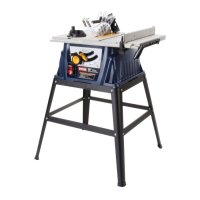What to do if Ryobi RTS10 Saw rip fence does not lock at rear?
- ZzbaileySep 13, 2025
If the rip fence does not lock at the rear on your Ryobi Saw, the clamp screw is likely out of adjustment. Adjust the clamp screw clockwise to resolve this issue.

What to do if Ryobi RTS10 Saw rip fence does not lock at rear?
If the rip fence does not lock at the rear on your Ryobi Saw, the clamp screw is likely out of adjustment. Adjust the clamp screw clockwise to resolve this issue.
| Type | Table Saw |
|---|---|
| No Load Speed | 5000 RPM |
| Blade Diameter | 10 in |
| Max Cut Depth at 45 Degrees | 2-1/4 in |
| Arbor Size | 5/8 in |
| Blade Diameter (mm) | 254 mm |
| Max Cutting Depth at 45° (mm) | 57 |
| Power Source | Electric |
Details the 90-day exchange policy for defective RYOBI power tools.
Specifies what defects are covered under the RYOBI power tool warranty.
Provides instructions on how to obtain warranty service for RYOBI power tools.
Outlines limitations, exclusions, and legal aspects of the RYOBI power tool warranty.
Warns about electrical shock risks and grounding requirements.
Advises on keeping the work area clean and personal preparedness.
Emphasizes keeping hands clear of the blade and avoiding contact.
Recommends protective gear and proper extension cord usage.
Covers safe operation practices and tool maintenance.
Ensures saw stability and provides methods to prevent kickback.
Mandates use of safety devices and proper workpiece handling.
Crucial warnings about blade path and keeping hands clear.
Stresses using correct blades and accessories.
Explains various safety, electrical, and operational symbols used.
Defines signal words (DANGER, WARNING, CAUTION, NOTICE) and their meanings.
Covers extension cord selection, grounding, and electrical connection requirements.
Defines essential terms related to safety and tool operation.
Lists technical specifications for the table saw.
Identifies and labels the main components of the table saw.
Explains blade guard, bevel scale, and adjusting handwheel.
Details the switch assembly and locking lever for safety.
Guides on safe unpacking, inspection, and assembly warnings.
Provides steps for assembling the leg stand and mounting the saw.
Instructions for installing handle, lever, guards, and aligning blade/spreader.
Covers general safety, kickback causes, and avoidance strategies.
Explains use of cutting aids like push sticks and featherboards.
Details types of cuts and how to adjust blade depth and angle.
Instructions for using and setting the rip fence and miter gauge.
Step-by-step guides for making cross, rip, miter, bevel, and compound cuts.
Critical safety warning to unplug the tool before making adjustments.
Procedures for replacing the blade and setting blade angles.
Steps to check and align the rip fence parallel to the blade.
Guidelines for cleaning, checking parts, and maintaining the tool.
Addresses issues like vibration, fence movement, and cutting problems.
Troubleshoots inaccurate cuts, starting issues, and motor laboring.
Provides health warnings and information on obtaining parts and service.
Details on how to get customer support and purchase replacement parts.
